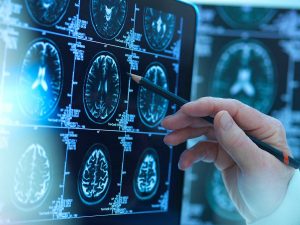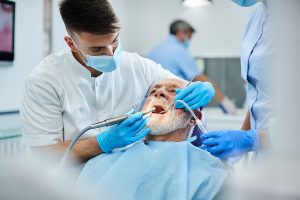Dr. Tom Moore argued forcefully in favor of the stay-at-home order that has helped limit the spread of COVID-19 cases in Wichita, Kan.
Moore appeared before the Sedgwick County Commission on March 24 to testify the order was necessary, and the order went out the very next day.
“Literally the very next day, we started to see more cases pop up,” said Moore, director of infection prevention at Wesley Medical Center in Wichita. “We just barely nipped it in the bud.”
Two weeks later, Moore started being peppered with the question now being debated across the nation.
“Now we’re getting a lot of people asking when things will go back to normal,” Moore said.
America will reopen for business, but to do so in a safe way will require a massive and ongoing investment in testing and health care, experts say.
“When we decrease social distancing, when we start to have more activity in the economy, there are going to be more cases. That’s a fact,” said Dr. Amesh Adalja, a senior scholar with the Johns Hopkins Center for Health Security in Baltimore. “The overriding principle has to be, can we keep the pace of those new cases at a rate that’s slow enough it does not impact hospital capacity?”
Americans should prepare themselves for a cautious, well-considered and phased-in reopening, with different areas lifting their lockdowns based on their local health care capacity and COVID-19 caseload.
“It’s not like turning on a light switch. Not everybody is going to be suddenly free to go wherever they want,” Moore warned.
Widespread testing has to be in place
U.S. President Donald Trump acknowledged this Thursday in new federal guidelines for a phased-in reopening that would be based on the judgment of state governors and local leaders.
“We are not opening all at once, but one careful step at a time,” Trump said during a media briefing Thursday. “And some states will be able to open up sooner than others. Some states are not in the kind of trouble that others are in.”
Rapid testing for COVID-19 will be essential in any effort to reopen the United States, so new outbreaks caused by the relaxation of social distancing can be quickly tamped down, said Dr. John Lynch, an associate professor of infectious disease at the University of Washington in Seattle.
“We need to have access to testing for people with even minimal symptoms,” Lynch said. “People need to get access to testing very easily, regardless of their insurance status, and those results need to be accessible to public health.”
There also has to be enough testing capacity to aggressively test in advance people who aren’t yet sick but are at high risk from COVID-19, said Dr. Tina Tan, a professor of pediatrics with the Northwestern University Feinberg School of Medicine in Chicago.
That includes testing both workers and patients in nursing facilities; jailors and inmates in prisons; front-line workers like transit drivers, police and firefighters; the homeless; and people in black communities that have been hit hardest by the pandemic.
But America is nowhere near this level of testing yet. Lynch and Tan estimated that testing in specific areas will need to be tripled or quadrupled — possibly even more — before responsible reopening can occur.
Contact tracing needs to be expanded
Testing is just the beginning. Communities also need enough public health staff to perform contact tracing for a person with COVID-19 — tracking down everyone they encountered and testing them as well, to find out how far the virus has spread, Lynch said.
“If our public health teams can do contact tracing and contact every infected person within 24 to 48 hours, I think that’s when we’re probably at adequate,” Lynch said. “In my city, we’re nowhere near that.”
Public health departments will need more funding, and they will need to be buttressed with medical students, college students and other volunteers to help with the detective work of contact tracing and case management for people in quarantine, said Lori Tremmel Freeman, chief executive officer of the National Association of County and City Health Officials.
“In our estimation, it’s probably going to take a hundred thousand of these workers at various levels of training to do this work,” Freeman said.
Governors and local officials also will have to take into account the capacity of hospitals to deal with sudden surges in COVID-19 cases that will result when the lockdown is lifted.
ICU beds will need to be open and available, and well-staffed hospitals will need to be equipped with enough protective gear and equipment to treat COVID-19 patients, Lynch said.
“When people do require hospitalization [for COVID-19], they’re in the hospital for a long time, particularly in the critical care units,” Lynch noted. “That number for us has remained stable for now a couple of weeks. We’ve not seen a decrease in the hospitalized number of cases.”
Once all those links are in place — testing, public health, hospital capacity — then governors can start issuing orders lifting lockdowns, experts said. The order in which lockdowns are lifted will be solely guided by local considerations.
Adalja thinks early emphasis will be given to reopening schools and day care centers. “That will help facilitate people getting back to work, if they don’t have to worry about child care,” he said.
Restaurants, bars and other businesses will reopen over time, but with restrictions in place limiting the number of people allowed inside. Even churches might be limited to 50 or fewer people congregating at once.
New social distancing considerations also might be applied, such as requiring grocery store aisles to be one-way, Adalja said. People will still be encouraged to telecommute; stickers will still remind you to remain 6 feet from the person nearest you.
Finally, there are some mass gatherings that simply will not resume until a COVID-19 vaccine can ensure widespread immunity, experts said. Don’t expect to attend a rock concert or sports event anytime soon.
“We’ll get to a new normal that is going to be different than what we had,” Adalja said. “This is going to be much more driven by local and regional considerations that are going to be decided by governors and mayors and county governments.”
More information
The Infectious Diseases Society of America has more about easing COVID-19 restrictions.
Source: HealthDay
Copyright © 2025 HealthDay. All rights reserved.

















